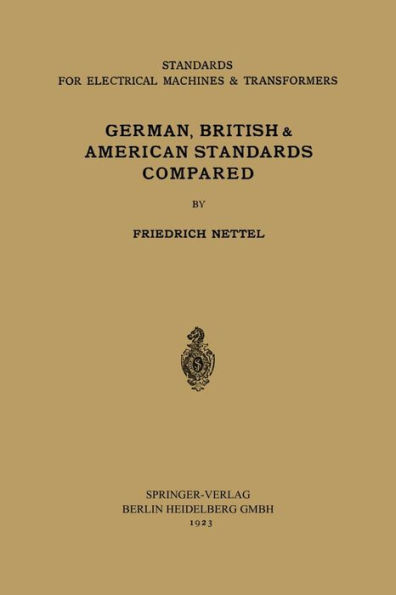Comparison of Principal Points of Standards for Electrical Machinery (Rotating Machines and Transformers)
The necessity and importance of the standardization of electrical apparatus was recognized in Germany as early as 1894 and . the first rules ("Sicherheitsvorschriften für elektrische Starkstromanlagen gegen Feuersgefahr") came into force in that country in 189S. In the U. S. of America the first discussion on Standardization of Generators, Motors and Transformers took place in 1898 which resulted in the appointment of a Committee and the subsequent acceptance of the rules proposed by it. In England the BritishEngineeringStandards Association was formed in IgOI. In connection with the British Standards an explanatory note appears necessary: The B. E. S. A. 's rules have for many years been the only generally accepted Standards. Since 19I3 the British Electrical and Ailied Manufacturers Association, representing the most important powerful British manufacturing firms, have issued Standardization Rules of their own which have attained considerable commercial importance, A special edition of these rules has been issued for export work which on the whole are guided by ideas similar to those embodied in the B. E. S. A. rules. As far as can be gleaned from the article in the th "Electrical Review" (Vol. 86 Nr. 2, 216, April 16 1920) it isintended to publish a new revision of the B. E. S. A. 's rules which will probably contain some of the recommendations of the B. E. A. M. A., so that this will probably mean the return to one single system of Standards for Britain.
1120211429
Comparison of Principal Points of Standards for Electrical Machinery (Rotating Machines and Transformers)
The necessity and importance of the standardization of electrical apparatus was recognized in Germany as early as 1894 and . the first rules ("Sicherheitsvorschriften für elektrische Starkstromanlagen gegen Feuersgefahr") came into force in that country in 189S. In the U. S. of America the first discussion on Standardization of Generators, Motors and Transformers took place in 1898 which resulted in the appointment of a Committee and the subsequent acceptance of the rules proposed by it. In England the BritishEngineeringStandards Association was formed in IgOI. In connection with the British Standards an explanatory note appears necessary: The B. E. S. A. 's rules have for many years been the only generally accepted Standards. Since 19I3 the British Electrical and Ailied Manufacturers Association, representing the most important powerful British manufacturing firms, have issued Standardization Rules of their own which have attained considerable commercial importance, A special edition of these rules has been issued for export work which on the whole are guided by ideas similar to those embodied in the B. E. S. A. rules. As far as can be gleaned from the article in the th "Electrical Review" (Vol. 86 Nr. 2, 216, April 16 1920) it isintended to publish a new revision of the B. E. S. A. 's rules which will probably contain some of the recommendations of the B. E. A. M. A., so that this will probably mean the return to one single system of Standards for Britain.
54.99
In Stock
5
1

Comparison of Principal Points of Standards for Electrical Machinery (Rotating Machines and Transformers)
42
Comparison of Principal Points of Standards for Electrical Machinery (Rotating Machines and Transformers)
42Paperback(1923)
$54.99
54.99
In Stock

Product Details
| ISBN-13: | 9783662244050 |
|---|---|
| Publisher: | Springer Berlin Heidelberg |
| Publication date: | 01/01/1923 |
| Edition description: | 1923 |
| Pages: | 42 |
| Product dimensions: | 6.10(w) x 9.25(h) x 0.00(d) |
From the B&N Reads Blog
